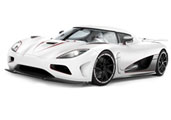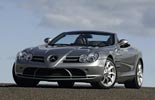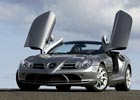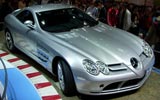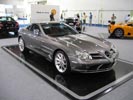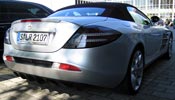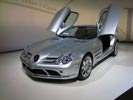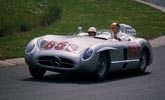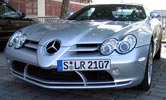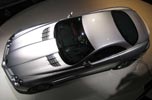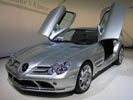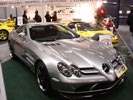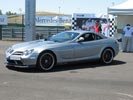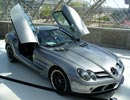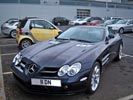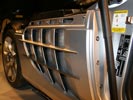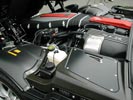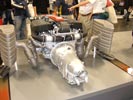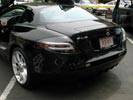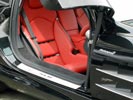The Mercedes Benz SLR McLaren is an Anglo-German sports car jointly developed by Mercedes-Benz and McLaren Automotive, built in Portsmouth and the McLaren Technology Centre in Woking, Surrey, England. Daimler AG, owner of Mercedes-Benz, also owns 40% of the McLaren Group.
Performance
The Mercedes SLR car uses carbon fiber for its entire body construction in an attempt to keep the weight low. Despite CFRP materials the total curb weight is 1768 kg (3898 lb).The following tests have proven that the SLR can achieve a 0-60 mph (97 km/h) in 3.1 seconds and reach a top speed of 360 km/h (224 mph) .
The Mercedes SLR achieved a 0-60 mph (100 km/h) time of 3.2 seconds, and a quarter-mile time of 10.1 seconds at 143 mph (230 km/h) C&D suggests the times may be even lower if temperatures were lower. Mercedes SLR achieved top gear acceleration 30-50 mph and 50-70 mph times of 1.7 and 2.4 seconds, which are the fastest ever recorded by the magazine 'Car and Driver' in a production car. The Mercedes SLR also pulled 0.98 g on the skidpad.January 2005.
Road and Track tested the Mercedes SLR car in their July 2005 Road Test and reached 60 mph (97 km/h) from a standstill in 3.1 seconds. The 0 - 100 mph (160 km/h) sprint was achieved in 6.2 seconds and a quarter mile run was completed in 10.2 seconds at 142 mph (229 km/h).
In June 2004 the Mercedes SLR was tested at Nardo and did a 0-100 km/h in 3.2 seconds and 200 km/h (124 mph) in 8.9 seconds and a 300 km/h (186 mph) in 24.4 seconds. Their 400 meter and kilometer times were 10.2 seconds at 142 mph (229 km/h) and 19.8 seconds at 278 km/h (173 mph) respectively. The Mercedes SLR also reached its claimed topspeed 360 km/h (224 mph) .
History
The Mercedes-Benz SLR McLaren is inspired by the Mercedes-Benz 300 SLR of 1955, based on the W196 F1 car, yet named after the road-going 300SL Gullwing. On 4 April 2008, Mercedes announced they will cease production of the SLR. The last of the coupes rolled off the production line at the end of 2007 and the roadster version is due to be discontinued in early 2009.
Brakes
The brake discs are carbon-ceramic and provide better stopping power and fade resistance than steel discs when operating under ideal working temperature. Mercedes-Benz claims these discs are fade resistant to 1,200 °C (2,200 °F). The front discs are internally vented and 370 mm (14.6 in) in diameter. 8 piston calipers are used. Rear discs are 360 mm (14.2 in) in diameter with 4 piston calipers. During wet conditions the calipers automatically skim the surface of the disks to keep them dry.
Rear view of the SLR McLaren Roadster
To improve braking performance there is an automatic air brake, when engaged the rear elevation angle of the rear spoiler is set to 65 degrees. The additional rear downforce in addition to the markedly increased aerodynamic drag increases peak deceleration ~25%.
Aerodynamics
The SLR features active aerodynamics; there is a spoiler mounted on the rear integral air brake flap. The spoiler increases downforce depending on its angle of elevation (angle of attack). At speeds above 95 km/h (59 mph) the spoiler/brake automatically raises to 10 degrees (15 in 722 edition), when demanded via the driver's switch, the elevation can be increased to 30 degrees (35 in 722 version) for increased rear downforce, at the cost of increased steady state drag.
Engine
The SLR McLaren sports a hand-built 5.4-litre, supercharged V8 engine.
The SLR sports a 232-kilogram (512 lb), hand-built, 5.4-litre (5439 cc/331.9 cu in), supercharged, all-aluminum, SOHC V8 engine. The cylinders are angled at 90 degrees with three valves per cylinder and lubricated via a dry sump system. The compression ratio is 8.8:1 and the bore and stroke is 97 millimetre (3.82 in) and 92 millimeters (3.62 in), respectively. The Lysholm-type twin-screw supercharger produces 0.9 bar (13 psi) of boost, the turbine rotates at 23000 revolutions per minute, and the air is cooled via two intercoolers. The engine generates a maximum power of 626 PS (617 hp/460 kW) at 6500 revolutions per minute and a maximum torque of 780 newton-metres (575 ft·lbf) at 3250 revolutions per minute. 2003 models were leaving showrooms at 616 bhp (459 kW/625 PS) and now are slightly increased to 626 bhp (467 kW/635 PS) .
Unlike most of its contemporaries, its engine is front-mid mounted. McLaren took the original concept car designed by Mercedes and moved the engine 1 metre (39.4 in) behind the front bumper, and around 50 centimetres (19.7 in) behind the front axle. They also optimized the design of the center firewall.
722 GT
The 722 GT is a tuned version of the SLR 722 which is developed for a one-make racing series. The cars are built by Ray Mallock Ltd. with approval from Mercedes-Benz. The car features new wider bodywork to accommodate 19 inch OZ racing wheels. The front grill vents are removed and larger, free flowing air extractors sit on the hood and flank the side of the car. The rear now has a racing wing and diffuser.
Under the body, the car has shed 398 kg and reduced its dry weight to 1300 kg (2866 lb). The engine remains in relatively stock specification but now produces 500 kW (680 bhp) and 830 N·m (612 ft·lbf) at 1.75 bar (175 kPa) boost. Inside, the car is stripped out with only the essential functions being controlled from a carbon fiber binnacle. New carbon fiber door panels and full roll cage complete the transformation. Only 21 examples of the 722 GT are planned to be made, all of which will be for racing use only. Each costs upward of €750,000.
Car - Mercedes SLR
Copyright © 1998-2013 you.com.au

